The language of Rus’, Ukraine and Russia


| Heritage of ancient Rus in the Ukrainian language | |
|---|---|
|
Some Ukrainians in rural areas find it difficult to pronounce the sound
”F” and pronounce ”ohvicer” instead of ”officer” or ”kohvee” instead of
”coffee”. This is not an epidemic of a defect in the pronunciation of sound
”F” as ”HV”. In the language of ancient Rus (like the Scythians,
too), there was no letter ”F” [1]. This is the heritage of ancient Rus in the
Ukrainian language (phonetics). How were these traits able to be preserved? With the Romanov dynasty coming to power, the Ukrainian language became the language of peasants from Przemysl to Voronezh. Cities begin to speak the language of the empire, and the Ukrainian language is not used in politics, government agencies and science [2]~[10]. The establishment of Soviet power brings some improvement, but the Ukrainian language is not allowed in college or university. So, the majority of the Ukrainian elite speaks Ukrainian only “on camera“, and in everyday life in the language of the empire. The Ukrainian language has been relegated to the level of private communication in the lands captured by Soviet Russia [3]. |
| The language of Rus’, Ukraine and Russia in comparison | |
|---|---|
| Let's start the review of the language with a reliable historical document in order to understand in comparison what the language of Rus’, Ukraine and Russia is [8]. | |
![The language of Rus’, Ukraine and Russia [8]](/images/The-language-of-Rus,-Ukraine-and-Russia.png) |
This is the original “parting word” of John the 4th Warlike (Terrible) [8]. |
| The comparison below is a sample of the most common language compatible expression taken from this document: | |
| ... верхъ рєчій пожаданыхъ є концемъ | Original (Rus) |
| ... верх рєчій пожаданых є концем | Original without “ъ“ * |
| ... верх речей пожаданих є кінцем | Ukrainian |
| ... верх вещей вожделенных есть концом | Russian |
| ... the top of things desired is the end | English |
| This comparison did not bring any sensation. In terms of vocabulary, Ukrainian and Russian coincide by 62%, and Ukrainian and Belarusian by 84% [4]. The Belarusian language is the closest to Ukrainian in terms of root group similarity, which reaches 92%, if their regional dialects are taken into account. The Russian language lost about 30% of its own words due to the replacement of native words with non-Slavic ones. This is another refutation of the myth that the Russian language is the main heir to the language of Rus’. | |
| *NOTE: The original without “ъ” (hard sign) brings the text to modern pronunciation, which, after the reform of the pronunciation of vowels, became hard by default, and soft ones began to require a soft sign (there are significantly fewer words with this pronunciation). |
| The heritage of the Rus’ language in the modern alphabets of its peoples | |
|---|---|
| The appearance of the printing press forced to optimize the graphics of the letters of the alphabet. Therefore, modern letters of the peoples of Rus’, including Ukraine, differ from the letters of ancient manuscripts. This does not explain the disappearance from the Russian alphabet of the printable letters ”І,Ї,Є” and the appearance of ”Э” and such an inconvenient letter as ”Ё”. Russian sources explain this by the influence of the alphabet of the fraternal Belarusian people. The statement that the modern Russian language is the main heir to the language of Rus’ requires to investigate this contradiction. Indeed, the modern Belarusian alphabet has such letters. | |
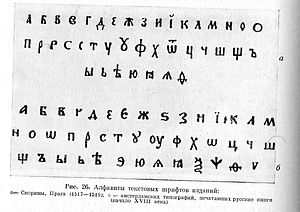 | Letter ”Э” appears only in the second variant of the ancient Belarusian alphabet, and no letter ”Ё” there [5]. But there are letters that are present in the Ukrainian alphabet: ”І,Ї,Є”. The version about borrowing these letters from the Belarusian alphabet is a fiction. What evil force forced Belarusians to get rid of their own letters and borrow someone else’s? |
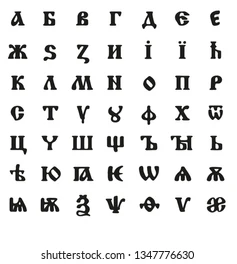 | In search of an answer, we will consider the ancient Russian alphabet [6]. It also has letters that are absent in the modern Russian and Belarusian alphabets (”І,Ї,Є”), but are present in the modern Ukrainian and the manuscripts of Ivan the 4th. There are no borrowed letters here. When considering the version of borrowing, we must examine the alphabets of the neighboring nations with which the Muscovite kingdom merged. First of all, these are Finno-Ugric peoples in the East, whose numbers exceeded the Muscovite Empire several times [7]. This should have the greatest influence on the language and alphabet of Muscovy. |
Consider the Mordovian alphabet [9], as the alphabet of the most numerous
people from the specified group of influence [7], which is confirmed by
the statistics of Russian DNA [11].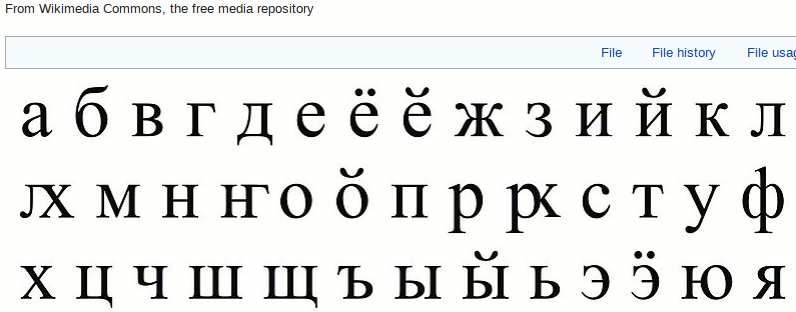 The Mordovian alphabet has the wanted letters ”Э,Ё”. They are native here, since there are two of them according to the phonetics of the Mordovian language. It also does not contain the letters ”і,ї,є”, which were abandoned by the Russian alphabet [9]. Unlike the Slavic alphabets, the Mordovian alphabet has two letters ”O” (with and without a tilde). Slavs do not have such a deep ”O”, which is also present in English-speaking peoples (sat between a and o or e). That is why Slavs hear ”London” as ”Landon” in English pronunciation. This suggests that the pronunciation of the word ”Moscow” as ”Mascow” may have a Mordovian origin. The facts presented here indicate that the Ukrainian alphabet carries the greatest heritage of ancient Rus’. | |
| Ukrainian dictionary - an archive of lost Russian words | |||||||||||||||||||||
|---|---|---|---|---|---|---|---|---|---|---|---|---|---|---|---|---|---|---|---|---|---|
|
Many people in Ukraine talk in “surzhik“ (mixed Ukrainian and Russian words).
This is regrettable, especially when a Ukrainian Slavic word is replaced by a
non-Slavic word that is borrowed in the Russian language.
During the years of Romanov dynasty rule, the Russian language was subjected to the greatest contamination with foreign words. Love for Western culture and contempt for the culture of Rus' forced them, and over time, the entire imperial elite to use more and more foreign words. This topic deserves a separate study that goes beyond the scope of this project. The most convincing example is the word “флаг“ (borrowed from flag). In Rus’ the words “horugvy“, “znamia“, “prapor“ and “stiag“ were used. It’s not all the same thing. A “stiag“ is triangular flad and was used only to control troops. A “Prapor“ is a simplification of a “znamia“ (flag that has symbols). A “horugvy“ may carry other symbols, including religious ones. In Russia, the words “horugvy“ and “prapor“ disappeared, but the rank of those who should bear them remained. The following table shows the presence and connection of these words in the Ukrainian and Russian languages.
And so, there are two military ranks in the Russian language that have lost touch with their purpose. Therefore, when Russians do not understand Ukrainian words, it is most often because they have replaced these words with foreign ones. Another example is words that are obsolete in the Russian language, especially in fairy tales, which may be present in the Ukrainian language: | |||||||||||||||||||||
| Девица краса, губы червлены за пяльцами сидит | Original (old Rus') | ||||||||||||||||||||
| Дівчина краса, губи червоні за п'яльцами сидить | modern Ukrainian | ||||||||||||||||||||
| Девушка краса, губы красные за прялкой сидит | modern Russian | ||||||||||||||||||||
| Beautiful girl with red lips is sitting at the spinning wheel | English | ||||||||||||||||||||
|
Surprisingly, the verb of the disappeared noun “пяльцы” (spinning wheel)
is still used in Russian as “staring” (“пялится”).
The borrowing of the foreign word “угол“ (corner) to replace own word “кут“ cuts the popular idiom “go to the left” from the root. The origin of this idiom referes to the old expression “woman’s corner“ in old books with old (replaced) words. It's unreadable in modern russian language but still used in ukrainian language as “babiy kut” (woman’s corner). What does it mean? Once upon a time in Rus' this meant a corner hung with fabric on the left side of the room where women changed clothes. In rich houses these are the women's rooms in the left wing. This is where the expression “go to the left” comes from, which meant visiting a “woman’s side“. That's not all, the verb from the replaced noun in Russian still “alive“ and used as “to wrap up“. | |||||||||||||||||||||
| The given examples are only a drop in the bucket of what can confirm: Ukrainian dictionary - an archive of lost Russian words | |||||||||||||||||||||
| Ukrainian language ban | |
|---|---|
| There are about 100 documents banning or restricting the use of the Ukrainian language (the primary dialect of Rus') [10]. The best known of them is Valuev’s circular [2]: | |
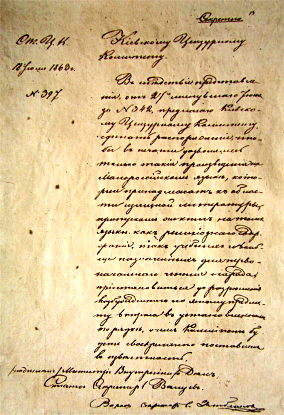 |
Valuev's circular - an order from the Minister of Internal Affairs of the Russian Empire
P.A. Valuev in 1863. It prohibited the printing of religious, educational, and literature intended
for elementary reading (fairy tales, for example) in Ukrainian. Only works of fine literature
were allowed to pass by the censor [2]. ( click on photo to enlarge) |
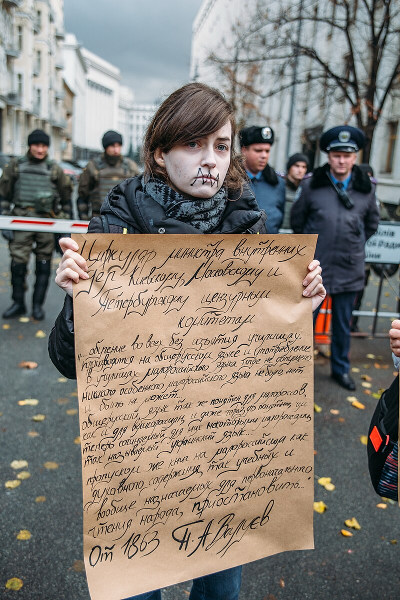
| Imitation of Valuev's circular on a poster during a protest against
“muscovization” (replacement of the dialect of native Rus' with the Moscow
dialect) in 2015. (click on photo to enlarge) |
| The history of the ban on the Ukrainian language goes back about 400 years and is the beginning of censorship in Russia [10]. | |
The crown of Muscovy's chauvinistic arbitrariness was the Emsk edict. Alexander II introduced amendments and signed the decree prepared by a special commission in the city of Bad Ems in 1876 year The Emsk decree supplemented the main provisions of the so-called Valuevskyi circular of 1863. | |
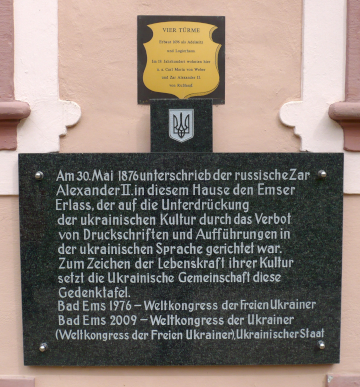
| On the left in the photo is a commemorative plaque dedicated to the Ems
decree in the city of Bad Ems. This decree prohibited the following areas of using Ukrainian
languages: [12] |
| In addition to the listed restrictions, the special commission developed specific instructions for higher educational institutions, closure of Ukrainian public organizations and persecution of the Ukrainian patriotic elite [13]. | |
| Conclusions | |
|---|---|
|
Territorial encroachments on Ukraine were based on the assertion that many
oppressed Russians lived in eastern Ukraine. This raised doubts as to whether
Ukraine was in fact a republic with a sufficient ethnic majority.
The appearance of these genetic studies has refuted these doubts [11]. Russia has changed the name of the population ”suppressed” in Ukraine from “Russians“ to “Russian-speaking“. Even before genetic research, there were other refutations of the fable about Russians in Ukraine. The largest migrations of people to the territory of Ukraine were caused by industrialization. Consequently, residents of other regions of the USSR had to settle around industrial centers. The following map shows the ratio of Ukrainian and Russian languages: | |
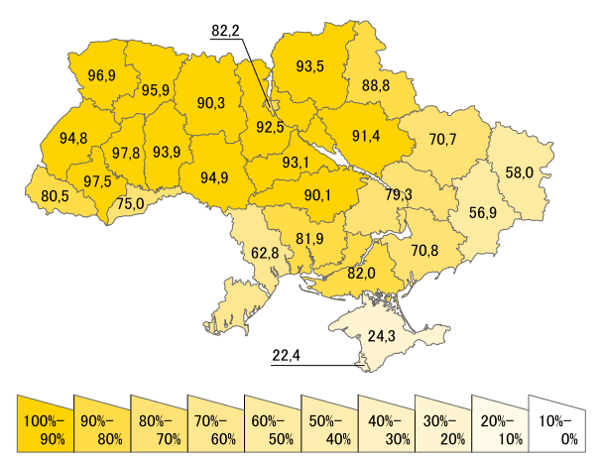
The above map does not show the centers of industrialization, but only repeats the wave of muscovization caused by numerous bans on the Ukrainian language [2]~[10]. It goes from east to west, just as the seizure of Ukrainian lands and the transfer of capitals took place. So the “Moscow-lingual“ residents of Ukraine are muscovizated Ukrainians, similar to those who remained in the territories separated from Ukraine [3]. |

Citations and references
| [1] | Source: | SCYTHIANS, these are not SKITHS, (the speech of ancient Rus’ in Ukraine) 2022 dzen.ru (Russian) |
|---|---|---|
| * | Mirror: | SCYTHIANS, these are not SKITHS, (the speech of ancient Rus’ in Ukraine) 2022 dzen.ru (Russian) |
| [2] | Source: | Ukrainian Language, Illinois University Library 2019 |
| [3] | Source: | Belgorod is the capital of Soviet Ukraine by Gennady Efimenko, 2017 “This day in history“ (Ukrainian) |
| * | Mirror: | Belgorod is the capital of Soviet Ukraine by Gennady Efimenko, 2017 (English) |
| [4] | Source: | Ukrainian language facts and uniqueness, Concierge Group 2024 (Russian) |
| * | Mirror: | Ukrainian language facts and uniqueness, Concierge Group 2024 (Russian) |
| [5] | Source: | Belarusian language, Wikipedia |
| * | Mirror: | Belarusian language, Wikipedia |
| [6] | Source: | Old Russian alphabet, Shutterstock |
| * | Mirror: | Old Russian alphabet, Shutterstock |
| [7] | Source: | Principality of Kiev Map of principalities of Rus’ in 1237 |
| * | Mirror: | Map of principalities of Rus’ in 1237 from wikipedia |
| [8] | Source: | Where to look for the unique Liberia of Ivan the Terrible?, livemem 2014 |
| * | Mirror: | Where to look for the unique Liberia of Ivan the Terrible?, livemem 2014 |
| [9] | Source: | Mordva alphabet, (1924-1927) Wikimedia Commons (Russian) |
| * | Mirror: | Mordva alphabet, (1924-1927) Wikimedia Commons (Russian) |
| [10] | Source: | A guide to the history of oppression of the Ukrainian language, by Olena Siruk 2022 |
| * | Mirror: | A guide to the history of oppression of the Ukrainian language, by Olena Siruk 2022 |
| [11] | Source: | Distribution of European Y-chromosome DNA (Y-DNA) haplogroups by country in percentage |
| * | Mirror: | Distribution of European Y-chromosome DNA (Y-DNA) haplogroups by country in percentage |
| [12] | Source: | Emsk decree of Alexander II on banning the Ukrainian language 1876 |
| * | Mirror: | Emsk decree of Alexander II on banning the Ukrainian language 1876 |
| [13] | Source: | Decree of the Russian Emperor Alexander II in 1876 on the fight against Ukrainophiles and the Ukrainian language |
| * | Mirror: | Decree of the Russian Emperor Alexander II in 1876 on the fight against Ukrainophiles and the Ukrainian language |
*Mirror: The mirror archive contains the same document as a source had at the publication time with a copyright attribues. Some documents may disappear from the Internet public access during the information war. It is why the most important documents are copied to the mirror archive. | ||

